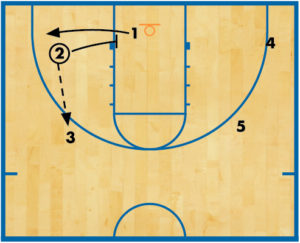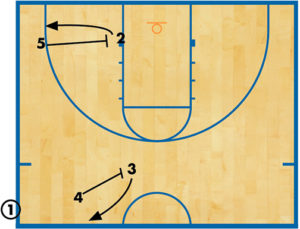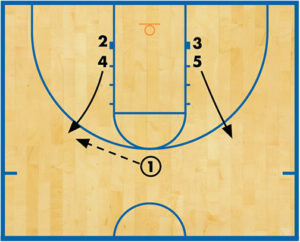’51’ attacks the post
This is an offensive play used against man-to-man defense. It has a few simple steps but can be a powerful asset for your team. This play is great to use in transition offense, for a quick basket or in late shot-clock situations.
In “51,” all of the five players are presented with an opportunity to score. This play is designed to create confusion and pressure on the defense, as well as create mismatches. Through creating an offensive advantage, the offense gains the opportunity to find the weak links in the opponents’ team defense or to attack weak individual defenders.
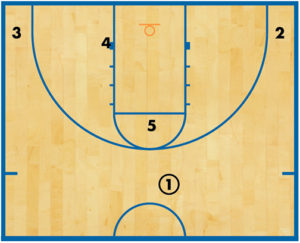 DIAGRAM 1: Initial setup. 1 is your point guard and should be centered a few feet past half court and a few feet behind the top of the key. The wing players are 2 and 3, and they are positioned in the corners behind the 3-point line. 4 is the post player on the low block, and 5 is the center in the middle of the free-throw half circle.
DIAGRAM 1: Initial setup. 1 is your point guard and should be centered a few feet past half court and a few feet behind the top of the key. The wing players are 2 and 3, and they are positioned in the corners behind the 3-point line. 4 is the post player on the low block, and 5 is the center in the middle of the free-throw half circle.
You need a certain type of player at each position to make this successful. 1 needs to be a playmaker and someone who can dribble, pass and score while making smart decisions. 2 and 3 must be capable of hitting open shots. 4 should be a skilled post player who can hit shots, and 5 should be capable of scoring in the paint and setting effective screens.
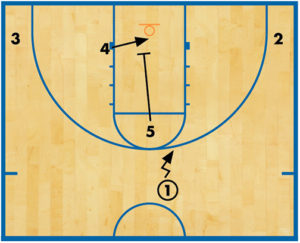 DIAGRAM 2: First action. 1 brings the ball up with both wings positioned in the corners behind the 3-point line. 4 is on any post block they choose, and 5 is in the middle of the free-throw circle. 5 drops down and sets a screen for 4. Before the screen takes place, 4 puts their head directly under the basket, dead center in the paint.
DIAGRAM 2: First action. 1 brings the ball up with both wings positioned in the corners behind the 3-point line. 4 is on any post block they choose, and 5 is in the middle of the free-throw circle. 5 drops down and sets a screen for 4. Before the screen takes place, 4 puts their head directly under the basket, dead center in the paint.
 DIAGRAM 3: Sprint. After 5 sets the screen, he or she stays on the low block and plays behind the vision of the defender. After 4 receives the screen from 5, 4 sprints to the area where 1 is located (about 24 feet from the goal). He then sets a flat ball screen.
DIAGRAM 3: Sprint. After 5 sets the screen, he or she stays on the low block and plays behind the vision of the defender. After 4 receives the screen from 5, 4 sprints to the area where 1 is located (about 24 feet from the goal). He then sets a flat ball screen.
4 sprinting is very important to the success of this play. The point of receiving a screen from 5 and sprinting for the ball screen is separation. If 4 can create any kind of separation between them and the defender, the play is already leaning in the offense’s favor. If separation is created, the point guard has the advantage of coming off the flat screen because there is no hedge.
Breaking down ’51’
After the point guard receives the flat ball screen, his or her job is to attack the post, putting the defense at a disadvantage. The point guard has plenty of options when this occurs, and they must be able to make reads and put enough pressure on the defense to find the best opportunity to score.
The point guard should have four options:
- Attack the post and drive for the layup.
- Attack the post and make a defender guarding the corner vacate their position to help. If they do, the point guard can kick out to a wing player for a 3-point shot.
- Attack the post and try to find 5 playing behind the defender for a lob or a layup. If the point guard passes the post defender, someone has to help. Most likely, it’s the defender guarding 5.
- Attack the post and, as the point guard’s defender attempts to recover, flip the ball to 4 for the open shot.

